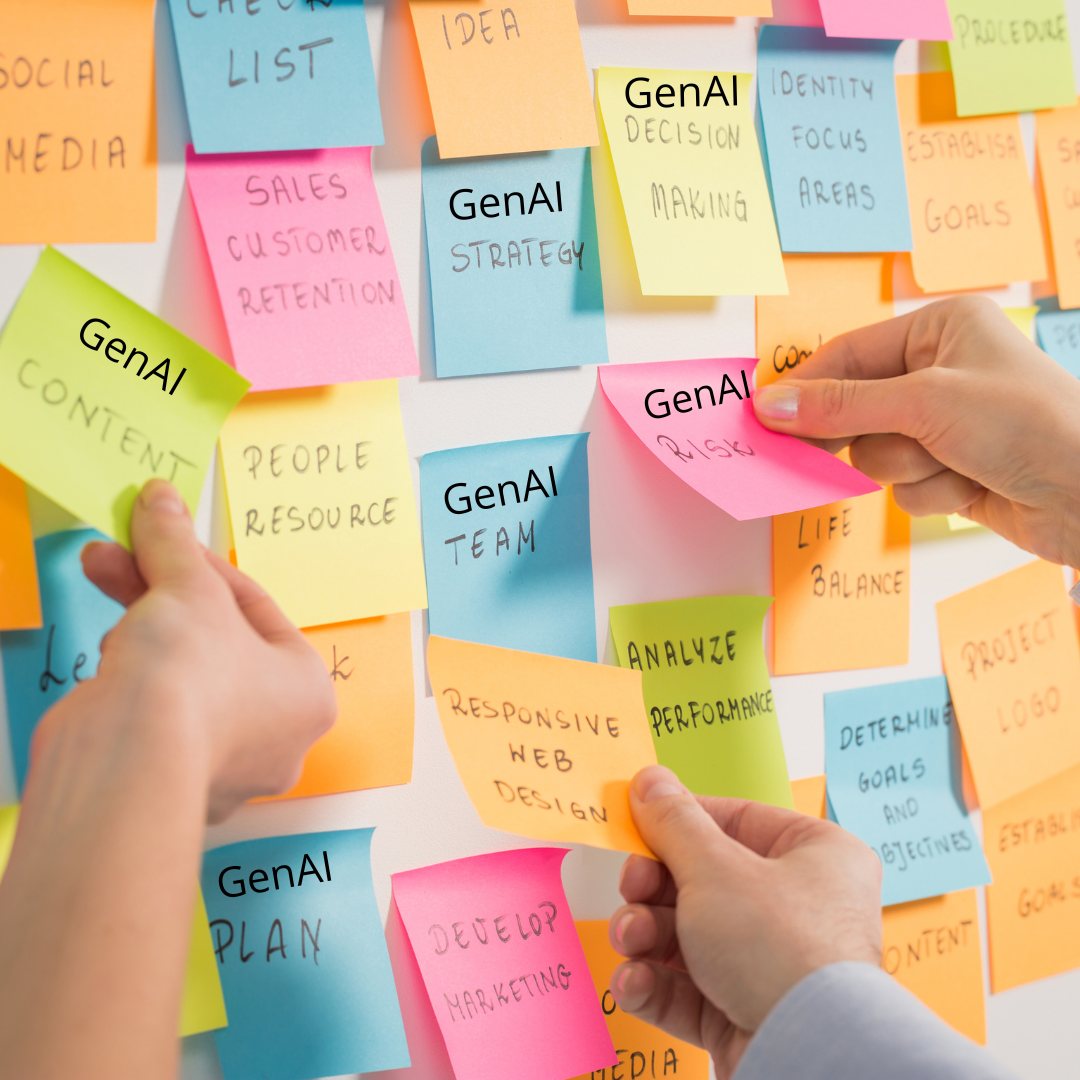50 Use Cases for GenAI Implementation Victory Now

In August 2024, Lohfeld Consulting sponsored a LinkedIn poll asking respondents, “Are you maximizing the benefits of your AI implementation?” Here’s what the survey said:
- 10% said their AI implementations are exceeding expectations
- 10% reported that AI is meeting most of their needs
- 42% reported there’s room for improvement
- 38% disclosed that AI isn’t delivering the expected benefits at all
This is a sobering statistic. Companies investing in generative artificial intelligence (GenAI) are learning that challenges can arise from unclear use cases, implementation delays, security concerns, inadequate user training, and system integration challenges. While your security, network, and development teams can help with implementation, bid and proposal leadership must ensure the tool is configured and the workforce prepared to achieve the highest return on investment (ROI).
Formulate a Clear Vision of GenAI Use Cases
One way bid and proposal leaders can facilitate GenAI tool implementation is by clearly defining the use cases it satisfies. This means identifying specific tasks or processes that AI tools can optimize, such as automating repetitive tasks, enhancing data analysis for better decision-making, and improving proposal writing quality, accuracy, speed, and efficiency. By aligning your GenAI implementation with strategic business goals, leadership ensures that the tool meets immediate needs and supports long-term growth and competitiveness. Moreover, setting measurable objectives and monitoring progress regularly will identify areas for improvement and ensure continuous alignment with evolving business needs.
50 Use Cases to Consider for GenAI Implementation
To kickstart your GenAI implementation, Lohfeld Consulting has identified 50 use cases where our capture and proposal experts are working with generative AI to apply best practices across our customers’ business development lifecycles. Before selecting a use case, clearly define your GenAI implementation goals, objectives, and the metrics you will use to measure success. Then, review the list presented below to find the use cases that would most benefit your operations. Next, rank them from highest to lowest based on their potential ROI for your company.
50 Use Cases to Consider, Rank, and Prioritize:
Business Development
1. Market Research Automation: Automate the collection and analysis of market data to identify trends and opportunities.
2. Lead Generation: Identify and prioritize potential leads based on data analysis and predictive modeling.
3. Competitor Analysis: Analyze competitors’ strategies and proposals to identify strengths, weaknesses, and gaps.
4. Customer Profiling: Develop detailed customer profiles and personas to tailor marketing and sales documents and draft proposal reviews.
5. Content Personalization: Create personalized marketing content that resonates with specific customer segments.
6. Predictive Sales Forecasting: Use AI to collect market trends and revenue information.
7. Social Media Analysis: Monitor social media platforms to understand customer sentiments and preferences.
8. Email Campaign Optimization: Automate email marketing campaigns with personalized content and optimized send times.
9. Customer Feedback Analysis: Analyze customer feedback to identify areas for improvement and innovation.
10. Event Planning and Management: Streamline the planning and management of events, including customer segmentation and personalized invitations.
Capture
11. Opportunity Identification: Use GenAI to automatically identify and qualify opportunities based on specific criteria.
12. Win Probability Assessment: Assess the likelihood of winning a bid based on the criteria you supply.
13. Bid/No-Bid Decision Support: Provide data-driven recommendations for bid/no-bid decisions.
14. Teaming Recommendations: Suggest potential partners or subcontractors or their characteristics based on their required capabilities and past performance.
15. Capture Plan Development: Generate comprehensive capture plans based on data analysis and best practices.
16. Competitive Intelligence Gathering: Automate intelligence collection on competitors’ past performances and strategies.
17. Customer Needs Analysis: Analyze customer needs and pain points to develop tailored solutions.
18. Compliance Checking: Automate compliance checks against RFP requirements to ensure all criteria are met.
19. Question Development: Use AI to develop questions to ask the customer during meetings or determine if you can improve your questions.
20. Risk Assessment and Mitigation: Identify potential risks in capture strategies and suggest mitigation plans.
Proposal Development
21. Kickoff Meeting Content Generation: Pull information from various sources to quickly gather information for the kickoff meeting.
22. Proposal Requirements List and Outline Generation: Automatically generate a list of requirements based on RFP requirements. Use the list of requirements to develop an outline based on your annotated instructions.
23. Content Library Management: Use AI to manage and update a centralized library, ensuring easy access to relevant content.
24. Proposal Writing Assistance: Provide writing suggestions and improve language and tone for clarity and impact.
25. Automated Formatting and Styling: Streamline document formatting and styling to meet compliance and aesthetic standards.
26. Visual Planning: Assist in conceptualizing visuals and graphics for proposals.
27. Content Optimization: Optimize proposal content for readability, engagement, and persuasiveness.
28. Proposal Review Automation: Automate the review process by flagging inconsistencies and suggesting improvements.
29. Proposal Review Commentary: After developing personas for your reviewers, let them score your proposal. Only use this use case as a preliminary indicator since these comments will likely vary each time it’s run.
30. Language Translation: Provide accurate translations of proposal content for international submissions.
Quality Assurance
31. Grammar and Spell Check: Use AI-powered tools to check and correct grammar and spelling errors.
32. Consistency Checks: Ensure consistency in terminology, branding, and formatting across proposal documents.
33. Readability Analysis: Assess the readability of proposals and suggest improvements for better comprehension.
34. Compliance Verification: Verify that all proposal sections are responsive to RFP requirements and criteria.
35. Executive Summary Generation: Automatically generate compelling executive summaries based on key proposal points.
36. Data Verification Check: Use GenAI to cross-check data points, figures, and statistics in proposals against sources or databases, ensuring accuracy and credibility.
37. Content Redundancy Check: Use GenAI to detect and flag repetitive content in proposals, allowing teams to streamline and refine the narrative.
38. Proofreading: Conduct thorough proofreading using GenAI to detect errors and inconsistencies.
39. Version Control and Management: Manage multiple versions of proposals and track changes efficiently.
40. Post-submission Analysis: Analyze the performance of submitted proposals and provide insights for future improvements.
Process Efficiency Enhancement
41. Workflow Automation: Automate repetitive tasks in the proposal development process to save time.
42. Resource Allocation Optimization: Optimize resource allocation by identifying bottlenecks and suggesting reallocations.
43. AI-driven Training and Onboarding: Provide training and onboarding for new team members using AI-driven modules.
44. Knowledge Sharing and Collaboration: Facilitate knowledge sharing and collaboration across teams using AI platforms.
45. Performance Metrics Tracking: Track key performance metrics for proposals and capture activities.
46. Deadline Management: Automatically track deadlines and send reminders to keep the proposal development on schedule.
47. Stakeholder Communication: Streamline communication with stakeholders by providing AI-generated updates and reports.
48. Proposal Template Creation: Automatically create customized proposal templates based on specific requirements.
49. Automated Document Formatting: Use GenAI to automatically format proposal documents according to predefined templates and guidelines.
50. Continuous Improvement Feedback Loop: Establish a feedback loop for continuous improvement by analyzing proposal outcomes and refining strategies.
Conclusion
GenAI has the potential to significantly enhance both the quality and efficiency of business development, capture, and proposal processes. GenAI tools allow teams to focus on strategic initiatives and create more compelling, high-quality proposals by automating routine tasks, ensuring compliance, and optimizing content. The 50 use cases we’ve highlighted can be used to show your bid and proposal leads how GenAI can be integrated into various stages of the proposal lifecycle, from initial planning to final submission. By thoughtfully implementing GenAI-driven solutions, organizations can improve their proposal outcomes and achieve a higher ROI, ultimately leading to greater success in winning new business.
By Brenda Crist, Vice President at Lohfeld Consulting Group, MPA, CPP APMP Fellow
Lohfeld Consulting Group has proven results specializing in helping companies create winning captures and proposals. As the premier capture and proposal services consulting firm focused exclusively on government markets, we provide expert assistance to government contractors in Capture Planning and Strategy, Proposal Management and Writing, Capture and Proposal Process and Infrastructure, and Training. In the last 3 years, we’ve supported over 550 proposals winning more than $170B for our clients—including the Top 10 government contractors. Lohfeld Consulting Group is your “go-to” capture and proposal source! Start winning by contacting us at www.lohfeldconsulting.com and join us on LinkedIn, Facebook, and YouTube(TM).
Paperback or Kindle
10 steps to creating high-scoring proposals
by Bob Lohfeld
contributors Edited by Beth Wingate
Subscribe to our free ebrief
Teaming friends, frenemies, and enemies—12 tips to mitigate harmful effects
Did you know that contracting officers spend up to 20% of their time mitigating disputes between teaming partners? In an informal poll we conducted on LinkedIn last month, 40% of respondents classified their teaming partners as “frenemies” on their last bid.
Explore Further
- Advice (539)
- AI (30)
- APMP (18)
- Army MAPS Contracts (3)
- Business Development (294)
- Capture Management (266)
- Complex Technology Grants Services (26)
- Favorite Books (5)
- GenAI (4)
- Go-to-Market (27)
- Graphics (5)
- Lohfeld Books (2)
- NASA SEWP VI Contracts (2)
- Navy SeaPort-NxG Contracts (2)
- NIST MSE Grants (1)
- NIST NAPMP Grants (2)
- Past Performance (63)
- Post-submission Phase (14)
- Pre-RFP Preparation (264)
- Proposal Management (341)
- Proposal Production (77)
- Proposal Reviews (40)
- Proposal Writing (109)
- Pursuit Phase (108)
- Research Report (4)
- Resources (63)
- Tools & Tips (423)
- Training (13)
- Uncategorized (223)

Sign Up for INSIGHTS and Download your FREE book
We'd love to help you with your proposals. Enjoy our complimentary Lohfeld Consulting Group Capture & Proposal Insights & Tips book with your FREE subscription to our Insights Newsletter.
GET YOUR FREE BOOK



